The color of health
Colorful fruits and vegetables pack a powerful, healthful punch.
By Sarah Webb
Nature is full of color, from rainbows and roses to butterfly wings and peacock tails. Even the fruits and vegetables you eat often have distinctive colors: intensely blue blueberries, deeply red strawberries, richly green broccoli, vividly orange carrots.
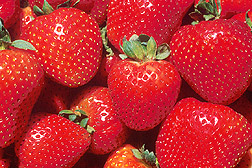 |
|
Strawberries.
|
| Brian Prechtel, U.S. Department of Agriculture |
Plants and animals often use color to attract attention. Deep, rich colors also provide another, important benefit for plants. Scientists have shown that the substances responsible for these colors actually help protect plants from chemical damage.
“When we see plants, we see a lot of different colors,” says Wayne Askew. “In particular, we see a lot of reds and greens and yellows.” Askew is a professor of nutrition at the University of Utah.
The good news for us is that, when we eat colorful fruits and vegetables, the pigments (or colorings) protect us, too.
Built-in sunscreen
The pigments responsible for plant color belong to a class of chemicals known as antioxidants. Plants make antioxidants to protect themselves from the sun’s ultraviolet (UV) light.
Ultraviolet light causes chemicals called free radicals to form within plant cells. If free radicals move through plant cells without being neutralized or eliminated, they can begin to destroy parts of the plant. Antioxidants stop free radicals in their tracks, shielding cells from harm.
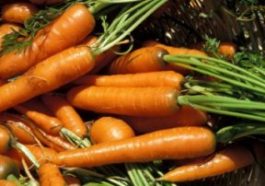 |
|
Carrots contain antioxidants that help protect cells from chemical damage.
|
| U.S. Department of Agriculture |
Typically, an intensely colored plant has more of these protective chemicals than a paler one does.
Free radicals aren’t a problem just for plants. They also affect people and animals. And ultraviolet light isn’t the only source of these damaging chemicals.
If you breathe polluted air, such as smog, automobile exhaust, or discharges from a factory, you take in chemicals that also cause such damage, Askew says. And, the body itself produces free radicals as it processes food.
White suit
All organisms use oxygen to convert food into energy, just as burning wood in a fireplace produces heat. At the same time, oxygen is involved in the production of free radicals that are often very similar to compounds needed by a cell to stay healthy.
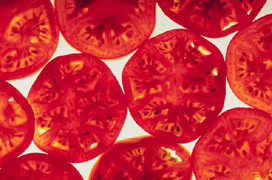 |
|
Tomatoes contain a powerful antioxidant.
|
| Scott Bauer, U.S. Department of Agriculture |
Free radicals are like a friendly dog that’s just been out in the mud, says James Joseph. He’s a nutrition researcher at Tufts University. If you play with the dog while wearing a white suit, the dog will leave muddy paw prints. Unfortunately, the dirt may permanently stain the suit.
It’s not as if the dog meant to hurt you, Joseph says. After all, it didn’t try to bite you. It merely wanted to bond with you.
Similarly, free radicals can bond with molecules in a cell, changing the molecules into forms that aren’t as useful or good for the cell as the originals were.
For example, free radicals can attack lipids—molecules that form a fence around cells to allow only certain chemicals to travel in and out of cells. They can also damage DNA, the genetic material that serves as the master plan for a cell and governs how it works. Proteins, the molecules in a cell that actually do the work of processing food, also face problems if they run into free radicals.
In general, free radicals can keep a cell from functioning properly.
Sunscreen on the inside
Our bodies have natural defenses for fighting off free radicals. The body makes certain molecules, known as antioxidants or repair enzymes, that stop free radicals before they can harm us. It’s like a video game of opposing chemical reactions in which good-guy repair enzymes battle bad-guy free radicals for control of cell and body.
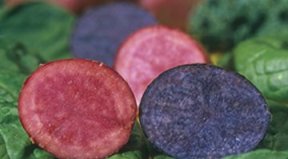 |
|
These newly developed, strongly colored potatoes have more flavor and greater potential health benefits that white potatoes do.
|
| Agricultural Research Service, U.S. Department of Agriculture |
While we’re young, our defenses are pretty strong. However, our natural defenses get weaker as we get older. The body’s built-in stoppers can only go so far without extra help.
And we can sometimes see the effects of free-radical, or oxidative, damage directly. Wrinkled skin, for example, is one sign of skin-cell damage. Certain cancers and heart disease are linked to free radicals. Overeating and obesity are linked to oxidative damage.
We can help by sending in reinforcements: antioxidants. For people, this means a lifestyle of consistently eating a variety of fruits and vegetables with intense colors. Joseph compares eating fruits and vegetables to “putting on sunscreen for the inside of your body.”
Recently, the U.S. Department of Agriculture released new guidelines that recommended we eat five to nine servings of fruits and vegetables each day.
Colorful food
The key to fighting free radicals with fruits and vegetables is to mix and match colors. Go for very bright colors and for many different colors.
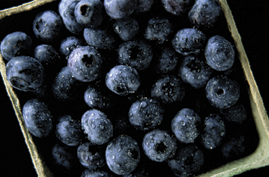 |
|
Blueberries.
|
| PhotoDisc |
If you’re looking for greens, spinach, broccoli, and dark green lettuces do the job. Pale iceberg lettuce packs little chemical bang per bite. For reds, strawberries and other berries are best, and tomatoes are tremendous. Carrots, oranges, sweet potatoes, and squash all shine among the yellow/orange foods.
In general, fresh fruits and vegetables are great, but dried or frozen forms of these foods can also be healthy.
Blue or purple foods, in particular, can be very beneficial, Joseph says. Have blueberries, Concord grapes, and eggplant, for example, on your menu as often as you can. These blue foods contain hundreds of healthful chemicals not found anywhere else, he says.
Joseph’s research on how chemicals in blueberries affect brain function in rats even suggests that these chemicals may help our own brains work more efficiently. Wouldn’t it be nice to be both healthier and smarter?
An antioxidant vitamin?
Antioxidants are just chemical compounds. Why can’t we just make a good antioxidant pill?
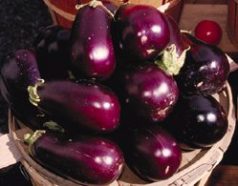 |
|
The deep purple color of eggplants shows that they contain antioxidants.
|
| Bill Tarpenning, U.S. Department of Agriculture |
People who have tried to make pills with antioxidants in them have found that the pills don’t seem to work as well as eating the fruits and vegetables themselves.
The different amounts of different antioxidants in the same food appear to work together to fight free radicals more effectively than the ingredients do by themselves, Askew says.
Nature has already worked out the right balance in plants. Scientists have a long way to go before they’ll really understand how much of each antioxidant chemical works best.
So, the next time you’re at a supermarket, you can shop for your own personal chemistry experiment. Pick out interesting fruits and vegetables with lots of different colors, then get to work in the kitchen. You might try preparing something that you’ve never tasted before, or you just might create a meal that’s both beautiful to look at and delicious to eat.
And, as you digest your meal, those colorful antioxidants will start doing their own chemistry on the inside, neutralizing free radicals and keeping you healthy.
Going Deeper:
News Detective: Cooking up a Colorful Menu
Antioxidants
Plants can produce a variety of antioxidants. Not all of them are pigments (and not all pigments are antioxidants).
Here are some examples of potent antioxidants that can be found in various fruits and vegetables:
- Vitamin C (ascorbic acid) — oranges, tangerines, sweet peppers, strawberries, potatoes, broccoli, kiwi fruit
- Vitamin E — seeds, nuts, peanut butter, wheat germ, avocado
- Beta carotene (a form of Vitamin A) — carrots, sweet potatoes, broccoli, red peppers, apricots, cantaloupe, mangoes, pumpkin, spinach
- Anthocyanin — eggplant, grapes, berries
- Lycopene — tomatoes, pink grapefruit, watermelon
- Lutein — broccoli, brussels sprouts, spinach, kale, corn







